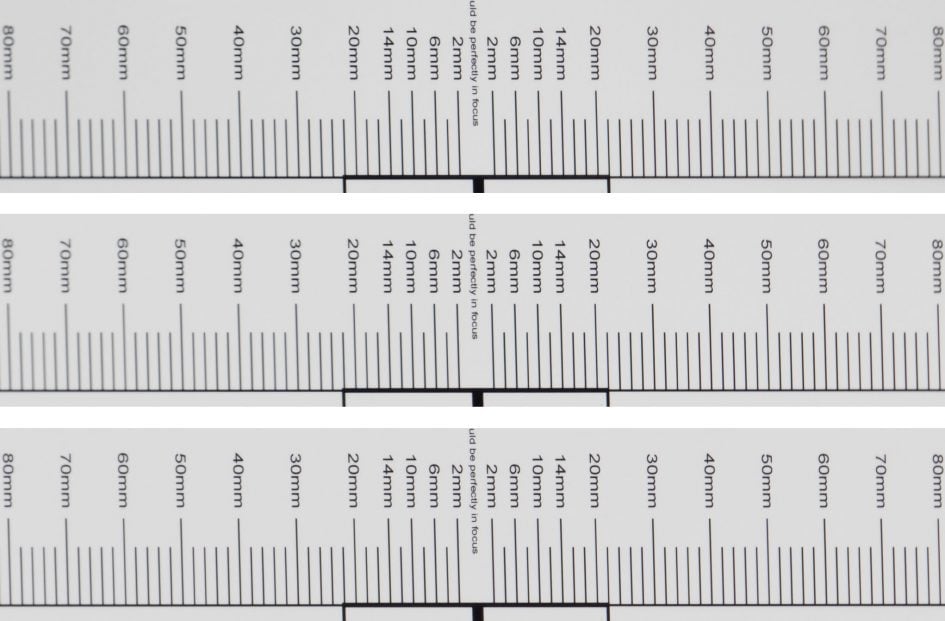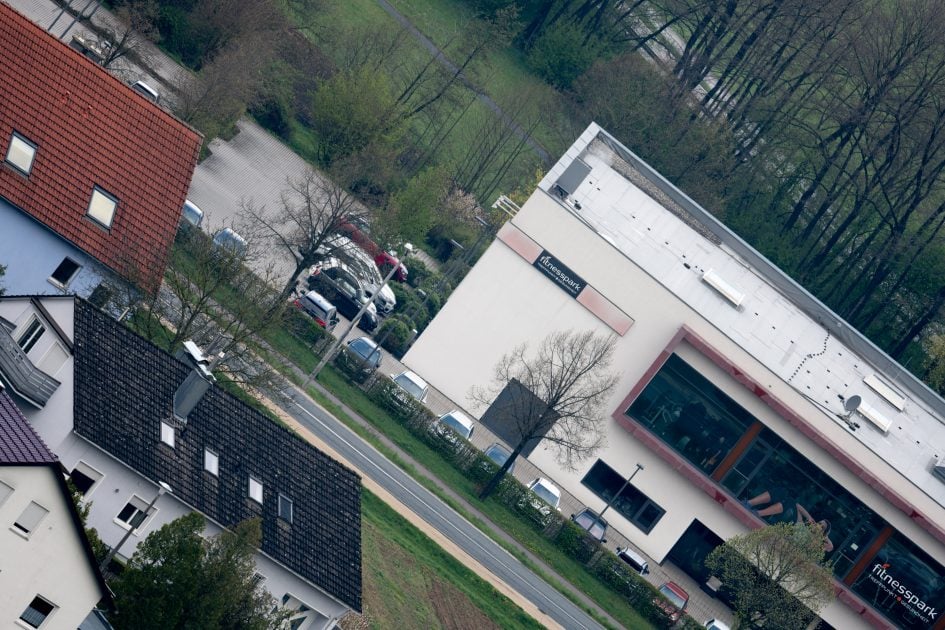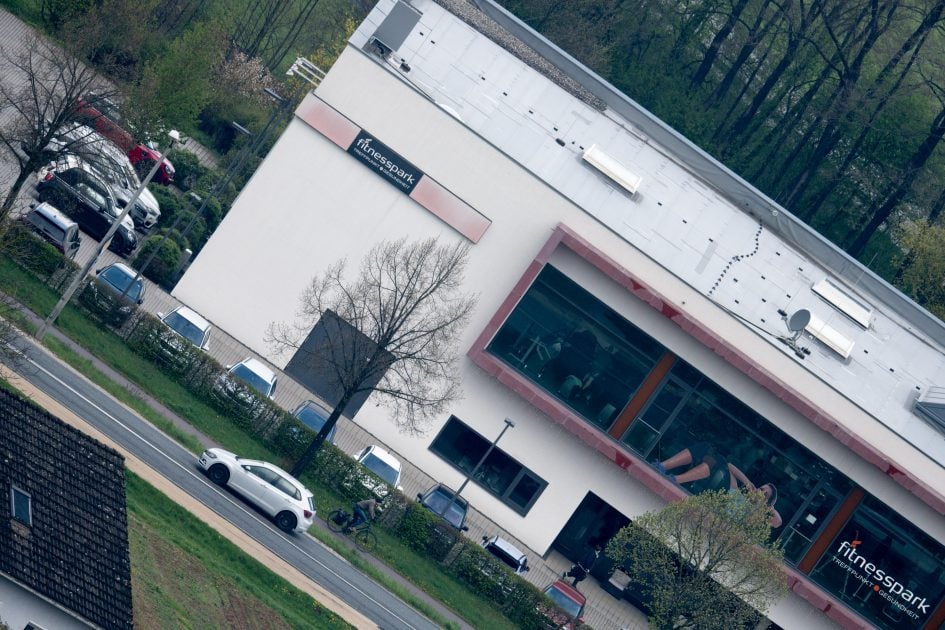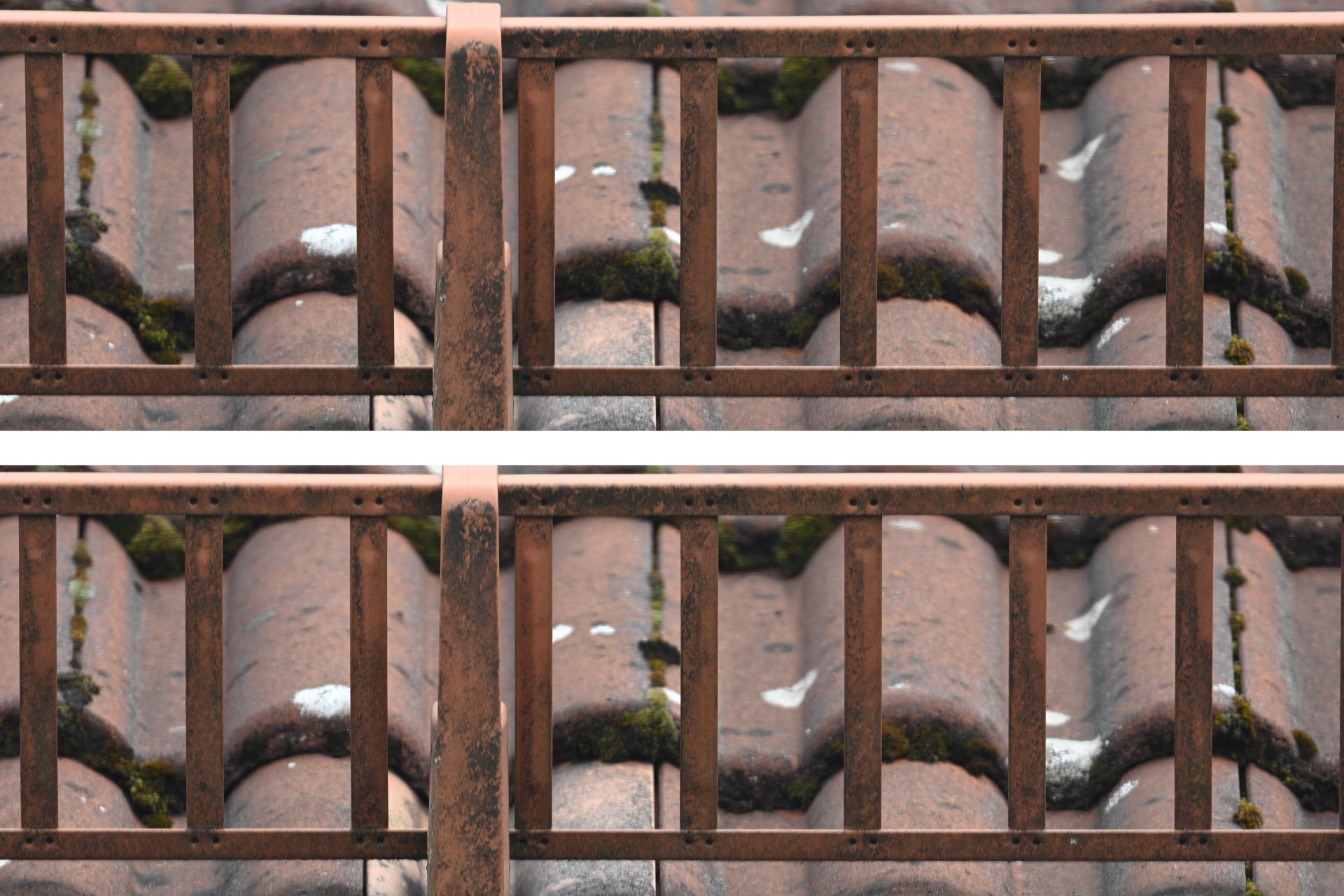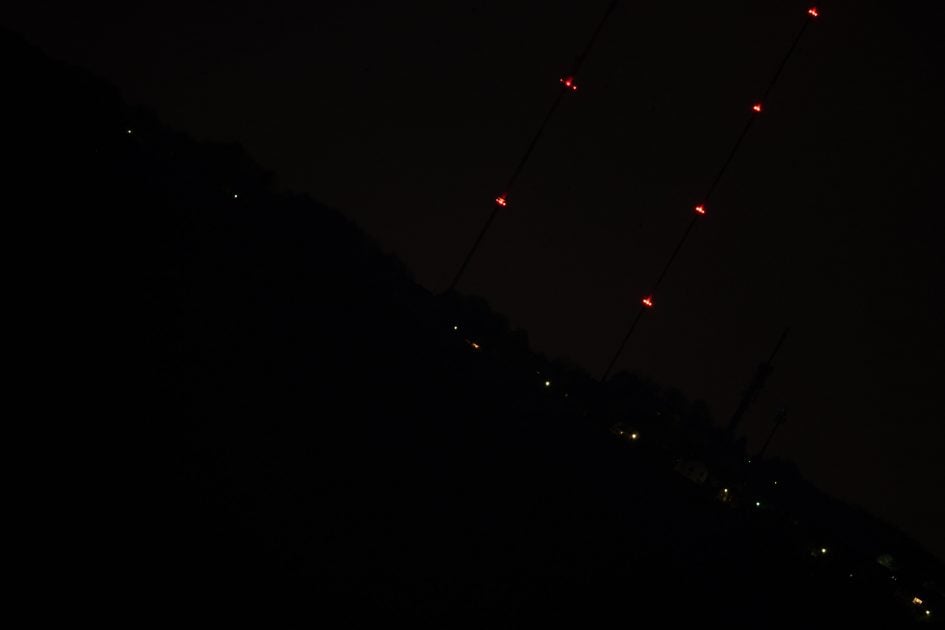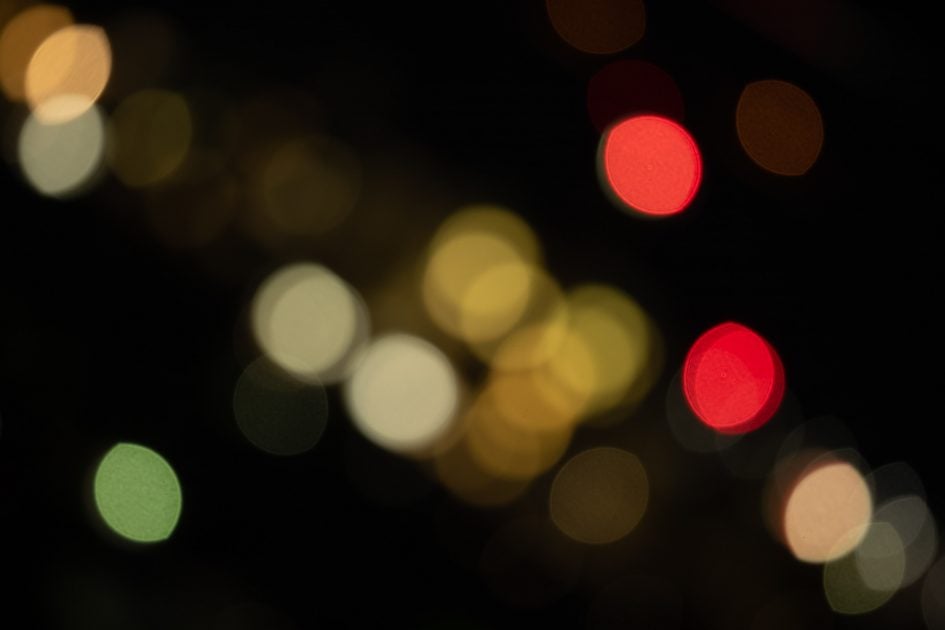Nikon Z 800mm f6.3 VR S review
-
-
Written by Thomas
Quality
Longitudinal Chromatic Aberration and focus shift
Longitudinal color aberrations (loCA, a.k.a. “axial color” or “bokeh CA”) cannot be easily corrected in post-processing. They show up as magenta coloration in the foreground and greenish hues in the background. But in my tests the new Z-Nikkor showed no discernible loCA. When stopped down the background becomes sharper faster than the foreground.
Nikon Z 800mm f6.3 VR S longitudinal Chromatic Aberration (loCA)
Above from top to bottom: f6.3, f8.0, f11; left = foreground, right = background, click image for 100% crops
In all of my test-shots with the Nikon Z 800mm f6.3 VR S I could not detect any purple fringing around high-contrast edges in the focus plane and no green outlining around background subjects. Very good!
Sharpness and contrast
Let’s have a look at the theoretical performance of the Nikon Z 800mm f6.3 VR S and compare it to its predecessor and the Nikon Z 400mm f2.8 TC VR S:
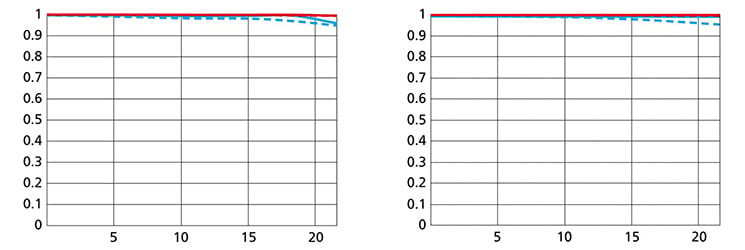
Above: Nikon Z 800mm f6.3 VR S at f6.3 (left), Nikon AF-S 800mm f5.6E FL ED VR at f5.6 (right)
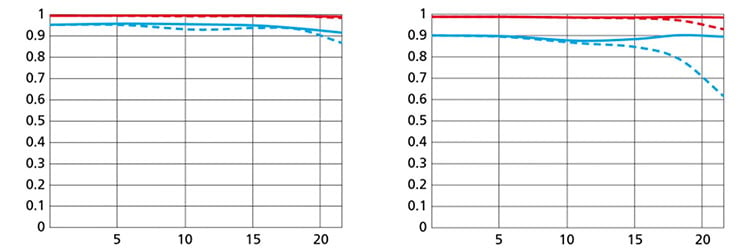
Above: Nikon Z 400mm f2.8 TC VR S at 400mm f2.8 (left), 560mm f4.0 (right)
These MTF charts show the computed lens-performance of lenses wide open at infinity without influence of diffraction at 10 line-pairs/mm (red) and 30 lp/mm (blue). Higher values are better (more contrast) and the closer the dotted and solid lines are together the less contrast dependents on the orientation of the test-pattern (less astigmatism). The x-axis displays the distance from the optical axis (=center of the sensor) in mm. I’ll show you real-life performance at 4 mm (“center”), 13 mm (APS-C/DX-corner), and 20 mm (FF/FX-corner) on a on a 45MP Nikon Z7 camera.
From the charts both 800mm lenses show extremely high overall contrast. But looking closely at the resolution of finer details the new Z 800mm f6.3 VR S seems to show just a tiny bit less contrast than its predecessor which should also show slightly less diffraction wide open. The Nikon Z 400mm f2.8 TC VR S is clearly less contrasty at fine details when used with its build in 1.4x teleconverter. Using it with an external Z TC-2.0x to reach 800mm focal length should reduce contrast even further.
Let’s see how this theoretical performance translates into real life results in the sharpness test based on Siemens-stars shot on a 45MP Nikon Z7. Processing was done in Lightroom 11.3/CRAW 14.3 from RAW to Adobe Color profile with the built-in lens profile for CA, vignette control and distortion compensation applied. Noise-reduction is set to 0, sharpening to 50/0.5/36/10, with no extra tone, color, or saturation adjustment. White-balance was adjusted to a neutral white and I did some exposure compensation to make the brightness of all crops match. So you will not see light fall-off in the corners.
The following 100% crops show the Nikon Z 800mm f6.3 VR S from wide open down to f11 compared to the Nikon Z 400mm f2.8 TC VR S + Z TC-2.0x at 800mm and 1120mm focal length.
Performance at 800mm:
Nikon Z 800mm f6.3 VR S at 800mm compared; 100% crop from center, DX-corner, FX-corner

Above: Nikon Z 800mm f6.3 VR S at f6.3

Above: Nikon Z 400mm f2.8 TC VR S + Z TC-2.0x at 800mm, f5.6

Above: Nikon Z 800mm f6.3 VR S at f8.0

Above: Nikon Z 400mm f2.8 TC VR S + Z TC-2.0x at 800mm, f8.0

Above: Nikon Z 800mm f6.3 VR S at f11

Above: Nikon Z 400mm f2.8 TC VR S + Z TC-2.0x at 800mm, f11
It is quite astonishing how well the Nikon Z 400mm f2.8 TC VR S + Z TC-2.0 performs in the center: it is even slightly sharper than the Z 800mm f5.6 VR S. But the new lens is clearly sharper outside the center delivering extremely even performance across the full-frame sensor. Stopping down to f8.0 improves contrast in the center a bit. And f11 sees a slight drop in acuity from diffraction.
Performance at 1120mm:
Nikon Z 800mm f6.3 VR S + Z TC-1.4x at 1120mm compared; 100% crop from center, DX-corner, FX-corner

Above: Nikon Z 800mm f6.3 VR S + Z TC-1.4x at 1120mm, f9.0

Above: Nikon Z 400mm f2.8 TC VR S + internal 1.4x TC + Z TC-2.0x at 1120mm, f8.0

Above: Nikon Z 800mm f6.3 VR S + Z TC-1.4x at 1120mm, f11

Above: Nikon Z 400mm f2.8 TC VR S + internal 1.4x TC + Z TC-2.0x at 1120mm, f11
Putting the Z TC-1.4x onto the Nikon Z 800mm f6.3 VR S makes it visibly softer. It is comparable to the Z 400mm f2.8 TC VR S + internal 1.4x TC + Z TC-2.0x in the center but delivers better resolution towards the corners. The Z 800mm f6.3 VR S + Z TC-1.4x again profits visibly in the center from stopping down to f11 – although diffraction is already setting in. I didn’t test the lens with the Z TC-2.0x but I suspect that would be overtaxing the lens’s abilities: I’d rather go for a DX-crop when I need an even narrower angle-of-view.
Field curvature is practically a non-issue with the lens, even if you use the external Z TC-1.4x!
All-in-all the Nikon Z 800mm f6.3 VR S is very sharp across the full frame when used on its own even wide open. When used in combination with a Z TC-1.4x the lens loses a bit of its bite.
Performance at long distances
The Siemens-star test-targets are shot at a distance of 45x focal length (i.e. at around 36m for 800mm focal length). But performance of lenses also depends on the shooting distance. Therefore I present another series of images shot on a 45MP Nikon Z 7 of a city around 1 km away. Processing was done in Lightroom 11.3/CRAW 14.3 from RAW to Adobe Color profile with the built-in lens profile compensating CA, vignetting, and distortions. Noise-reduction is set to 0, sharpening to 50/0.5/36/10, with no extra color or saturation adjustment. But as high humidity reduced overall contrast of the scene I pulled the whites up and the blacks down in postprocessing to create a dynamic range which is more comparable to my usual test-shots. All shots were made from a heavy tripod with image stabilization switched off and I used ISO 200 for 800mm focal length and ISO 1000 for 1120mm focal length to minimize the risk of micro-blur. As the Z 800/6.3 was only minimally decentered there was no need to selected the diagonal that provided the better corner results.
The following images show the complete scene wide open plus 100% crops roughly from the center, DX-corner, and FX-corner. You can access the large originals but these files are for personal evaluation only and cannot be used in another publication or website without permission..
Nikon Z 800mm f6.3 VR S
Above: Nikon Z 800mm f6.3 VR S at f6.3; click image for 4k version, here for large original; crops also available at f8.0, f11
Above: Nikon Z 800mm f6.3 VR S + Z TC-1.4x at 1120mm, f9.0; click image for 4k version, here for large original; crops also available at f11
The Nikon Z 800mm f6.3 VR S again performs nicely in this long-distance test producing very sharp images wide open – even right into the FX-corner at 800mm as well as with the Z TC-1.4x at 1120mm.
Vignetting and distortions
To make it easier to see light fall-off in the corners of a full-frame sensor I’ve arranged a series of three shots each with the Nikon Z 800mm f6.3 VR S. All images were developed to the same brightness in the center and are shown with vignette control Off (1st row) resp. Normal (2nd row):
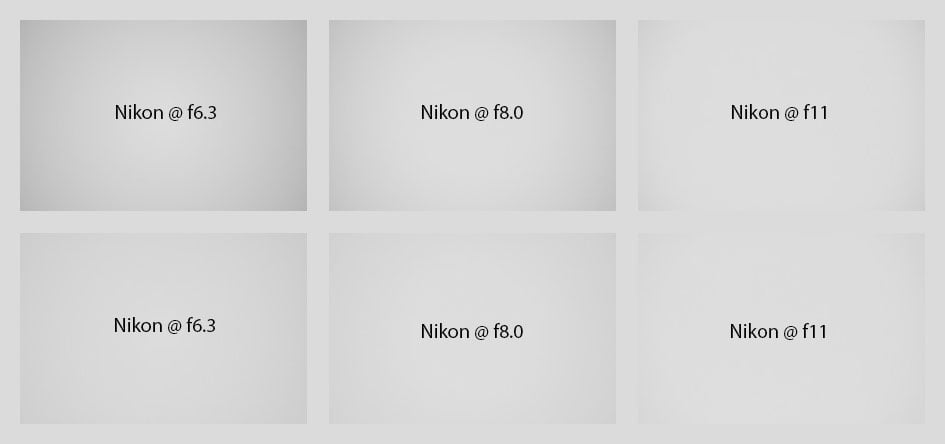
Above: Nikon Z 800mm f6.3 VR S
Wide open vignetting is pretty mild even without lens profile. With vignette control set to normal the extreme corners are lifted about 0.5 EV when the aperture is wide open. Adobe’s RAW converter automatically applies vignette control as it was set in camera – but you cannot alter the setting in postprocessing.
The setting for distortion compensation in camera is currently ignored by Adobe’s RAW converter and treated as On. But JPGs straight out of camera show the lens to have some mild pincushion distortions. The following composite images show a roof rail at the upper border of the full-frame image first without distortion compensation (JPG) and then with compensation from the built-in lens profile applied to RAW:
Distortions: Nikon Z 800mm f6.3 VR S, auto distortion control Off (top), On (bottom)
Rendering of point-light sources at night-shots
Night-shots pose a different challenge for lenses as the contrast is even higher than under bright sun and point-light sources can reveal some weaknesses such as coma, haloing and colour-aberrations that do not show up as prominently in other test-shots. The 100% crops below the main image show the effect of coma in the FF-corner of the Nikon Z 800mm f6.3 VR S at different apertures:
Above: Nikon Z 800mm f6.3 VR S f2.8; click image for 4k version, here for large original
The Nikon Z 800mm f6.3 VR S produces very little coma even wide open. The test also shows no color artifacts around bright streetlights.
Bokeh quality
This test is for the rendering of point-light sources in an out-of-focus background. The circle of confusion that is produced by the test is pretty indicative of Bokeh performance (in the background) and light fall-off. Ideally the out-of-focus image of the point-light is evenly lit and perfectly circular, with no “onion-rings”, and without coloration. Large aperture lenses normally produce an effect known as “cat’s eye” the further away from the optical axis the point-light is projected. This is due to optical vignetting in the lens barrel when light enters the lens from an angle.
Above: Nikon Z 800mm f6.3 VR S at f6.3; 4k versions available at f6.3, f8.0, f11
The diameter of the Bokeh balls in the center is determined by the entrance pupil of the lens which is a huge 127mm. Compression of the circle towards the corners is OK wide open. The circle of confusion clearly shows the aperture blades from f11 onwards – which should produce good diffraction spikes. There is a bit of outlining – albeit without coloration from loCA. The inside of the Bokeh balls is smoothly textured except for the red balls which show a brighter spot and some concentric rings. In the absence of aspheric lens elements I assume this is an “echo” of the Phase-Fresnel element.
Head over to my page with sample images which were all shot wide open to get a better impression of how Bokeh of the lens looks in different situations. I personally find it smooth in the transition zone with the background not overly prone to double contours.

Above: Nikon Z 800mm f6.3 VR S at f6.3, 50% crop; click image for 100% crop, here for large original
Close-up performance
The following shots were taken with the Nikon Z 800mm f6.3 VR S at its maximum magnification of 1:5.8. The crops shown below are from 2mm, 12mm, and 20mm off the center of the sensor respectively, the area of sharp focus is 139 x 209mm.
Nikon Z 800mm f6.3 VR S, 1:5.8 magnification; 100% crops

Above: Nikon Z 800mm f6.3 VR S at f6.3

Above: Nikon Z 800mm f6.3 VR S at f8.0

Above: Nikon Z 800mm f6.3 VR S at f11
Close-up performance is very good already wide open even into the corners. Stopping down to f8 improves acuity a tiny bit. Field curvature is very low, in this test all crops are from the same shot.
Next check out my sample images!
Check prices on the Nikon Z 800mm f6.3 S at B&H, Adorama, WEX UK or Calumet.de. Alternatively get yourself a copy of my In Camera book, an official Cameralabs T-shirt or mug, or treat me to a coffee! Thanks!